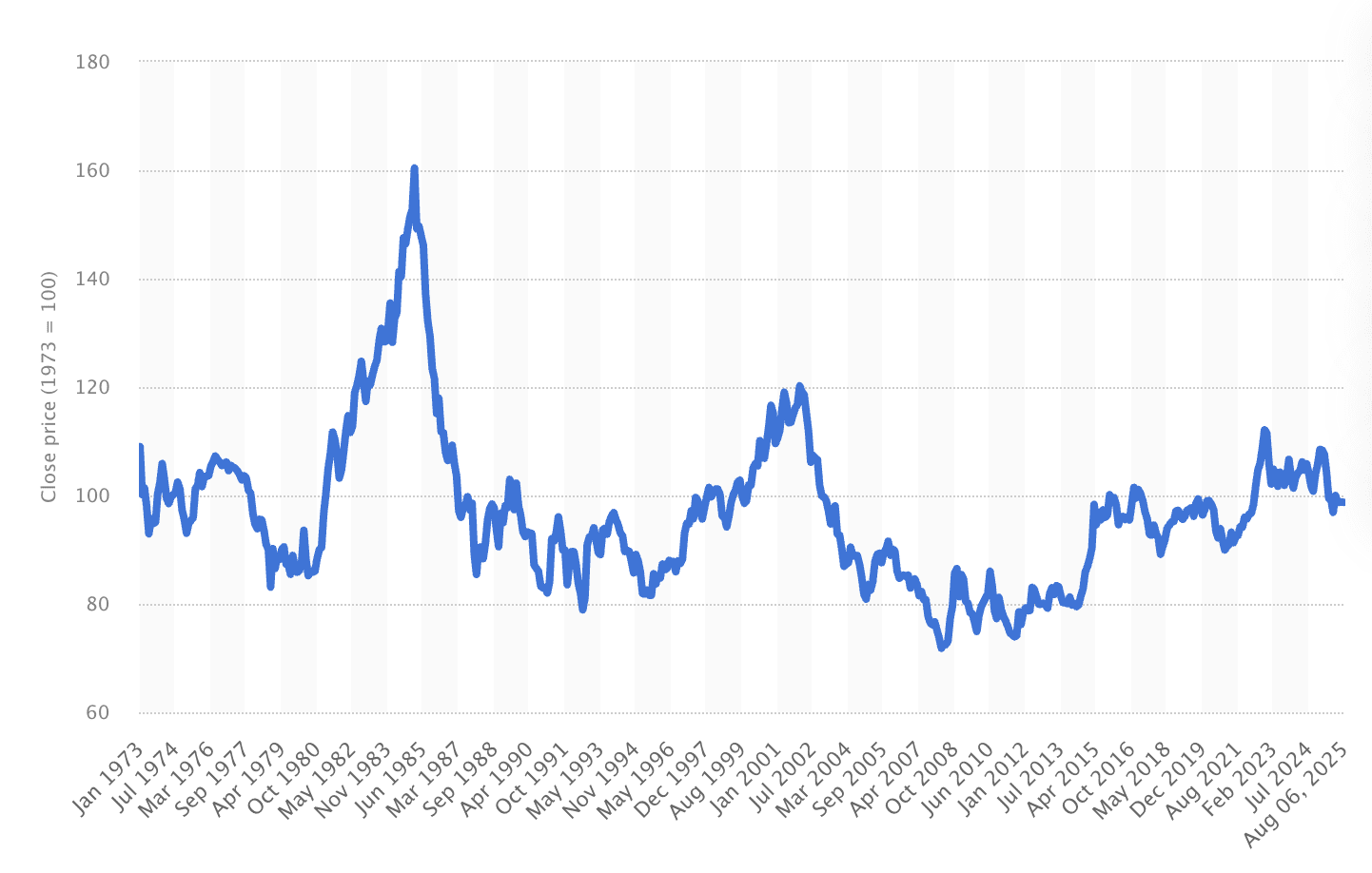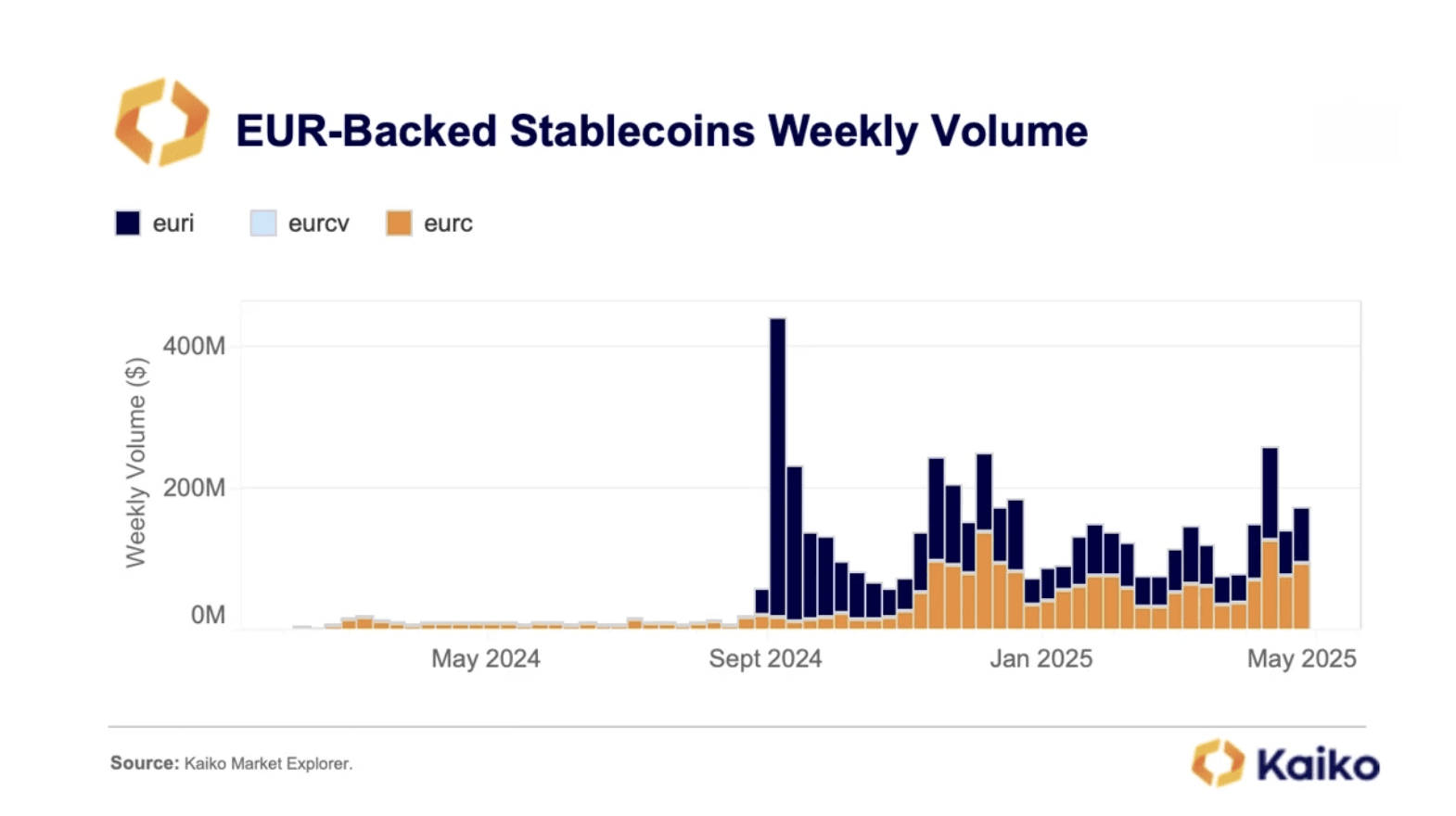
With the weakening dollar, an opportunity arises for the euro's role in the crypto economy. The growing adoption of Euro-backed stablecoins reflects the desire of European investors to counterbalance the currency exchange impact on their dollar-denominated assets.
Luke Nolan, Senior Researcher at CoinShares, told BeInCrypto that he expects this trend to continue, although he does not believe that the dollar's role will be completely eliminated from the landscape.
A 50-year decline for the dollar
In recent months, the dollar has experienced a significant and rapid decline. Its performance in the first six months of 2025 was the worst for the first time since 1973.
According to Morgan Stanley, the value of the dollar fell approximately 11% against other currencies in the first half of this year, marking its largest decline in over 50 years and ending a 15-year growth period.
 Dollar Index. Source: Statista.
Dollar Index. Source: Statista.
Investor confidence in the US economy and its assets has been shaken by unpredictable government policies, especially regarding tariffs and trade.
The recently approved “One Big Beautiful Bill Act” exacerbated these concerns by increasing fears about rising budget deficits and the country’s growing debt.
These policies have led investors to move away from US government bonds. Given the continuity of these policies, Morgan Stanley also projected that the dollar would fall another 10% by the end of 2026.
With investor focus shifting away from the notion of US exceptionalism, currencies like the euro, the dollar's main competitor, may gain ground. This trend may be especially pronounced in the crypto sector.
Is the dollar's dominance in crypto coming to an end in Europe?
The previously unquestioned stability and dominance of the dollar has traditionally served as the foundation of the global financial system, and the cryptocurrency market is no exception.
For many European investors, the recent decline of the dollar has created an intriguing problem. At first glance, a stable price for Bitcoin in dollars may seem positive. However, this masks a critical currency dynamic.
“If a European investor... owns Bitcoin purchased through an exchange, and holds it for a period where the price remains exactly the same, but the dollar has weakened against the euro, then the investor will lose, in real terms, that difference,” Nolan told BeInCrypto.
This currency impact demonstrates why European investors are becoming more aware of currency risk. They are realizing that their returns are not only tied to Bitcoin's performance but are also directly exposed to the strength or weakness of the dollar.
“This would be reflected in the BTC/EUR denomination, just as if the investor withdraws, even if in dollars, because once converted back to euros, they will end up with fewer euros than they invested,” added Nolan.
In light of this issue, European investors are taking practical steps to protect their crypto portfolios from dollar volatility.
Counterbalancing the impact of currency exchange
The long period of strength for the dollar previously made purchasing dollar-denominated assets attractive, offering what Nolan calls a “double win” for European investors. However, with the current macroeconomic shift, this dynamic has reversed.
As a result, a significant shift towards Euro-denominated trading is underway. This reevaluation of currency risk is also reflected in market data.
According to research by Kaiko, trading pairs quoted in Tether USD (USDT) on European exchanges lost popularity in 2025. In its place, EUR-denominated trading is gaining strength. The market data provider also found that liquidity for ETH/EUR pairs has doubled year over year, indicating that the trend extends beyond Bitcoin.
 Volume of Euro-backed stablecoins over time. Source: Kaiko Research.
Volume of Euro-backed stablecoins over time. Source: Kaiko Research.
For European investors, this shift is not just a strategic change, but rather a direct response to macroeconomic forces.
“I would say there is an impact, but it is not massive... Now, with the weakening dollar, if they are buying using dollar-denominated stablecoins (or withdrawing through them), then the decision becomes twofold: Do I think Bitcoin will rise and outperform the USD/EUR pair?” said Nolan.
By trading and holding crypto in native EUR pairs, they are working to “partially counterbalance this currency drag,” as Nolan noted, moving towards a more direct and less risky way to participate in the digital asset market.
This shift suggests that the European market is maturing, developing its own methods and infrastructure to suit its specific economic conditions.
A new era for Euro-denominated assets
The shift to Euro-denominated trades has brought renewed focus on Euro-pegged stablecoins.
Even though they are a smaller player in the crypto sector, their recent growth is undeniable. These digital assets offer a way to transact on the blockchain without being exposed to a weakened dollar.
“It is noticeable, but still a small fish in the big scheme of things. EURC (Circle) grew 55% in the year to 211 million, EURS (Statis) grew 31% in the year to 146 million. The total market value of stablecoins in EUR is 585 million dollars. Still very small in the grand scheme of things. (250 billion dollars total market value for stablecoins),” Nolan told BeInCrypto.
The practical utility of these stablecoins is especially significant for professional investors and businesses. They offer a way for treasuries to keep funds in crypto assets without incurring currency risks. This ability to operate directly in terms of Euro is a major attraction.
“Treasuries can now operate entirely in EUR, which avoids currency risk (at least partially). Therefore, I would expect that if the dollar's weakness continues, Euro-pegged stablecoins may gain more popularity,” added Nolan.
This recent trend also raises a larger question about the long-term role of the dollar in the crypto market.
Will the dollar's dominance in crypto decrease?
The emerging shift towards the Euro and broader global efforts for dedollarization lead to consideration of whether the crypto market will follow the same path.
According to Nolan, the outcome is complex and likely not as extreme as the term suggests. While the increase in Euro-denominated products is significant, it is unlikely to fundamentally impact crypto. The scale and dominance of USD-pegged stablecoins continue to reinforce the dollar's global role.
“I think it is quite unlikely to impact the crypto markets as a whole. USD stablecoins are still growing very quickly, and they really support global dollarization due to being natural buyers of US Treasury bonds,” he explained.
However, this does not mean that the trend should be dismissed. While large-scale dedollarization is not imminent, Nolan acknowledges that the market shift is clear. For example, the growth of Euro-pegged stablecoins provides a concrete metric for this change.
“I think that by the end of the year, being above 1 billion dollars in Euro-pegged stablecoins seems quite likely,” added Nolan.
This trend points to a future where the crypto market is more diversified. While the dollar is likely to remain in the lead, the Euro and other currencies will become more influential. This will create a more localized and less risky environment for investors and businesses.
The article Stablecoins in euro and weak dollar may change crypto investments was first seen on BeInCrypto Brazil.


